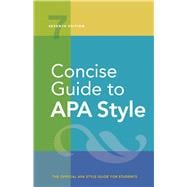Concise Guide to APA Style, Seventh Edition is the official APA Style resource for students.
Written for high school and undergraduate students, instructors, and writers learning APA Style, this easy-to-use pocket guide is adapted from the seventh edition of the Publication Manual of the American Psychological Association. It provides complete guidance for new writers on effective, clear, and inclusive scholarly communication and the essentials of formatting papers and other course assignments.
The seventh edition has been thoroughly revised and updated to reflect best practices in scholarly writing and publishing.
- Full color throughout
- Content relevant to a range of majors and courses, including psychology, social work, criminal justice, communications, composition, education, business, engineering, and more
- New chapter focused on student papers
- Sample student title page, paper, and annotated bibliography
- Streamlined APA Style headings and in-text citations
- New chapter on writing style and grammar
- Chapters on punctuation, lists, italics, spelling, capitalization, abbreviations, numbers, and statistics
- Latest bias-free language guidelines
- More than 20 new sample tables and figures
- Comprehensive guidelines on citation to help writers credit their sources appropriately and avoid plagiarism and self-plagiarism
- More than 100 new reference templates and examples, including traditional sources (e.g., journal articles, books, dissertations, and reports) plus many others (e.g., social media, webpages and websites, legal)









